Advanced Operating Technique for Centralized and Decentralized Reservoirs Based on Flood Forecasting to Increase System Resilience in Urban Watersheds
Abstract
1. Introduction
2. Methodologies
2.1. Production of Artificial Rainfall Data
2.2. Advanced Flood Forecasting Technique
2.3. Advanced Operation for Centralized and Decentralized Reservoirs
2.4. Resilience of UDSs
3. Application and Results
3.1. Information of the Target Watershed
3.2. Application of Advanced Flood Forecasting
3.3. Application of Advanced Operation for Centralized and Decentralized Reservoirs
3.4. Resilience of Advanced Operation with Advanced Flood Forecasting
4. Conclusions
Author Contributions
Funding
Acknowledgments
Conflicts of Interest
References
- Lee, E.H.; Lee, Y.S.; Joo, J.G.; Jung, D.; Kim, J.H. Investigating the impact of proactive pump operation and capacity expansion on urban drainage system resilience. J. Water Resour. Plan. Manag. 2017, 143, 04017024. [Google Scholar] [CrossRef]
- Gaudio, R.; Penna, N.; Viteritti, V. A combined methodology for the hydraulic rehabilitation of urban drainage networks. Urban Water J. 2016, 13, 644–656. [Google Scholar] [CrossRef]
- Beeneken, T.; Erbe, V.; Messmer, A.; Reder, C.; Rohlfing, R.; Scheer, M.; Schuetze, M.; Schumacher, B.; Weilandt, M.; Weyand, M. Real time control (RTC) of urban drainage systems—A discussion of the additional efforts compared to conventionally operated systems. Urban Water J. 2013, 10, 293–299. [Google Scholar] [CrossRef]
- Cembrano, G.; Quevedo, J.; Salamero, M.; Puig, V.; Figueras, J.; Martı, J. Optimal control of urban drainage systems. A case study. Control Eng. Pract. 2004, 12, 1–9. [Google Scholar] [CrossRef]
- Fiorelli, D.; Schutz, G.; Klepiszewski, K.; Regneri, M.; Seiffert, S. Optimised real time operation of a sewer network using a multi-goal objective function. Urban Water J. 2013, 10, 342–353. [Google Scholar] [CrossRef]
- Fuchs, L.; Beeneken, T. Development and implementation of a real-time control strategy for the sewer system of the city of Vienna. Water Sci. Technol. 2005, 52, 187–194. [Google Scholar] [CrossRef] [PubMed]
- Galelli, S.; Goedbloed, A.; Schwanenberg, D.; van Overloop, P.J. Optimal real-time operation of multipurpose urban reservoirs: Case study in Singapore. J. Water Res. Plan. ASCE 2012, 140, 511–523. [Google Scholar] [CrossRef]
- Hsu, N.S.; Huang, C.L.; Wei, C.C. Intelligent real-time operation of a pumping station for an urban drainage system. J. Hydrol. 2013, 489, 85–97. [Google Scholar] [CrossRef]
- Kroll, S.; Fenu, A.; Wambecq, T.; Weemaes, M.; Van Impe, J.; Willems, P. Energy optimization of the urban drainage system by integrated real-time control during wet and dry weather conditions. Urban Water J. 2018, 15, 1–9. [Google Scholar] [CrossRef]
- Lund, N.S.V.; Falk, A.K.V.; Borup, M.; Madsen, H.; Steen Mikkelsen, P. Model predictive control of urban drainage systems: A review and perspective towards smart real-time water management. Crit. Rev. Environ. Sci. Technol. 2018, 48, 1–61. [Google Scholar] [CrossRef]
- Pleau, M.; Colas, H.; Lavallée, P.; Pelletier, G.; Bonin, R. Global optimal real-time control of the Quebec urban drainage system. Environ. Model. Softw. 2005, 20, 401–413. [Google Scholar] [CrossRef]
- Raimondi, A.; Becciu, G. On pre-filling probability of flood control detention facilities. Urban Water J. 2015, 12, 344–351. [Google Scholar] [CrossRef]
- Schütze, M.; Campisano, A.; Colas, H.; Schilling, W.; Vanrolleghem, P.A. Real time control of urban wastewater systems—Where do we stand today? J. Hydrol. 2004, 299, 335–348. [Google Scholar] [CrossRef]
- Vanrolleghem, P.A.; Benedetti, L.; Meirlaen, J. Modelling and real-time control of the integrated urban wastewater system. Environ. Model. Softw. 2005, 20, 427–442. [Google Scholar] [CrossRef]
- Zacharof, A.I.; Butler, D.; Schütze, M.; Beck, M.B. Screening for real-time control potential of urban wastewater systems. J. Hydrol. 2004, 299, 349–362. [Google Scholar] [CrossRef]
- Sweetapple, C.; Astaraie-Imani, M.; Butler, D. Design and operation of urban wastewater systems considering reliability, risk and resilience. Water Res. 2018, 147, 1–12. [Google Scholar] [CrossRef] [PubMed]
- Lee, E.H.; Lee, Y.S.; Joo, J.G.; Jung, D.; Kim, J.H. Flood reduction in urban drainage systems: Cooperative operation of centralized and decentralized reservoirs. Water 2016, 8, 469. [Google Scholar] [CrossRef]
- Xu, W.D.; Fletcher, T.D.; Duncan, H.P.; Bergmann, D.J.; Breman, J.; Burns, M.J. Improving the multi-objective performance of rainwater harvesting systems using real-time control technology. Water 2018, 10, 147. [Google Scholar] [CrossRef]
- Todini, E. Looped water distribution networks design using a resilience index based heuristic approach. Urban Water J. 2000, 2, 115–122. [Google Scholar] [CrossRef]
- Prasad, T.D.; Park, N.S. Multiobjective genetic algorithms for design of water distribution networks. J. Water Resour. Plan. Manag. 2004, 130, 73–82. [Google Scholar] [CrossRef]
- Farmani, R.; Walters, G.A.; Savic, D.A. Trade-off between total cost and reliability for Anytown water distribution network. J. Water Resour. Plan. Manag. 2005, 131, 161–171. [Google Scholar] [CrossRef]
- Mugume, S.N.; Gomez, D.E.; Fu, G.; Farmani, R.; Butler, D. A global analysis approach for investigating structural resilience in urban drainage systems. Water Res. 2015, 81, 15–26. [Google Scholar] [CrossRef] [PubMed]
- Siekmann, T.; Siekmann, M. Resilient urban drainage—Options of an optimized area-management. Urban Water J. 2015, 12, 44–51. [Google Scholar] [CrossRef]
- Huff, F.A. Time distribution of rainfall in heavy storms. Water Resour. Res. 1967, 3, 1007–1019. [Google Scholar] [CrossRef]
- Yoon, Y.N.; Jung, J.H.; Ryu, J.H. Introduction of design flood estimation. J. Korea Water Resour. Assoc. 2013, 46, 55–68. [Google Scholar]
- Lee, E.H.; Kim, J.H.; Choo, Y.M.; Jo, D.J. Application of Flood Nomograph for Flood Forecasting in Urban Areas. Water 2018, 10, 53. [Google Scholar] [CrossRef]
- United States Environmental Protection Agency. Storm Water Management Model User’s Manual Version 5.0. EPA; United States Environmental Protection Agency: Washington, DC, USA, 2010.
- Lee, E.H.; Choi, Y.H.; Kim, J.H. Real-Time Integrated Operation for Urban Streams with Centralized and Decentralized Reservoirs to Improve System Resilience. Water 2019, 11, 69. [Google Scholar] [CrossRef]
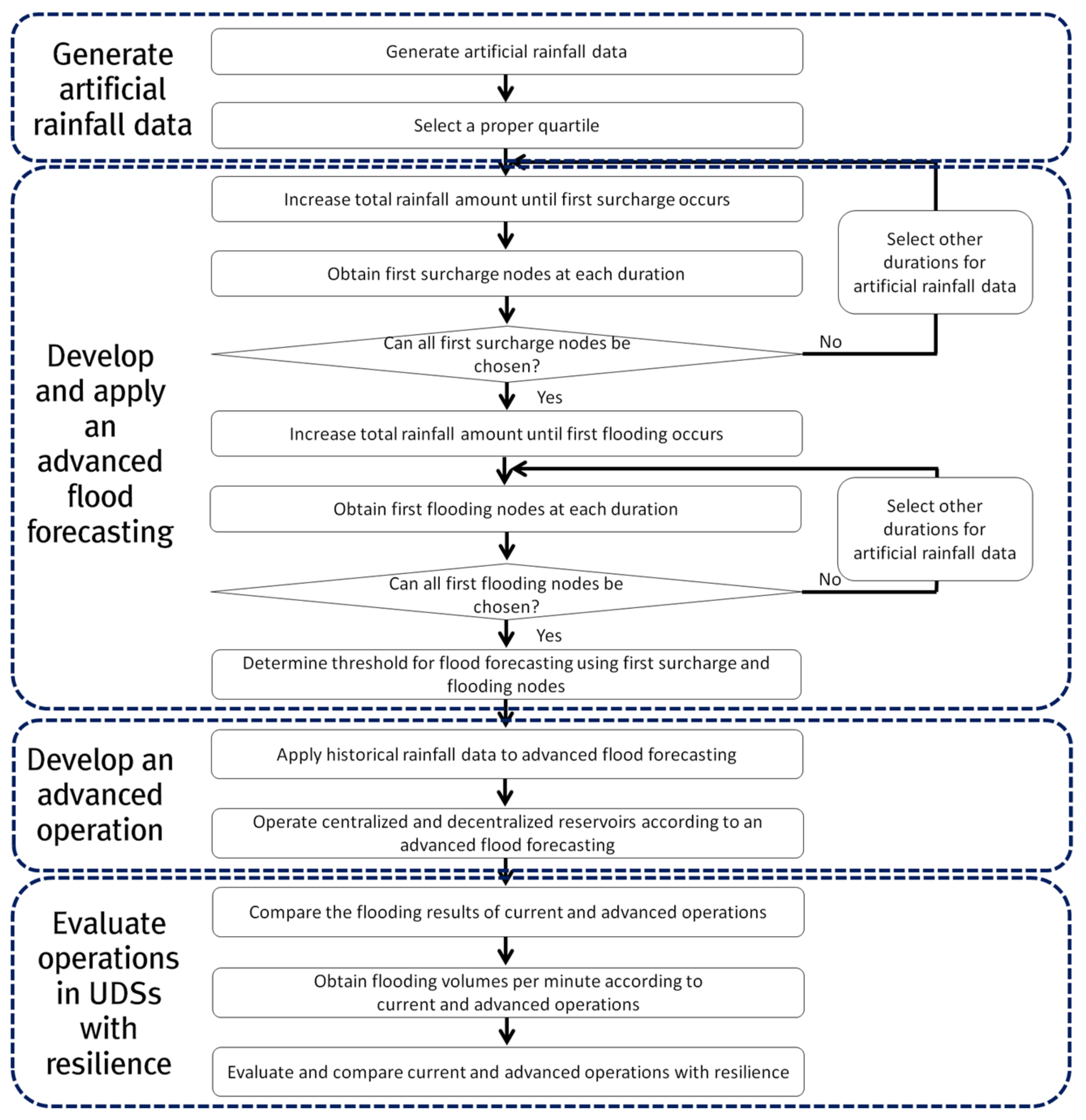

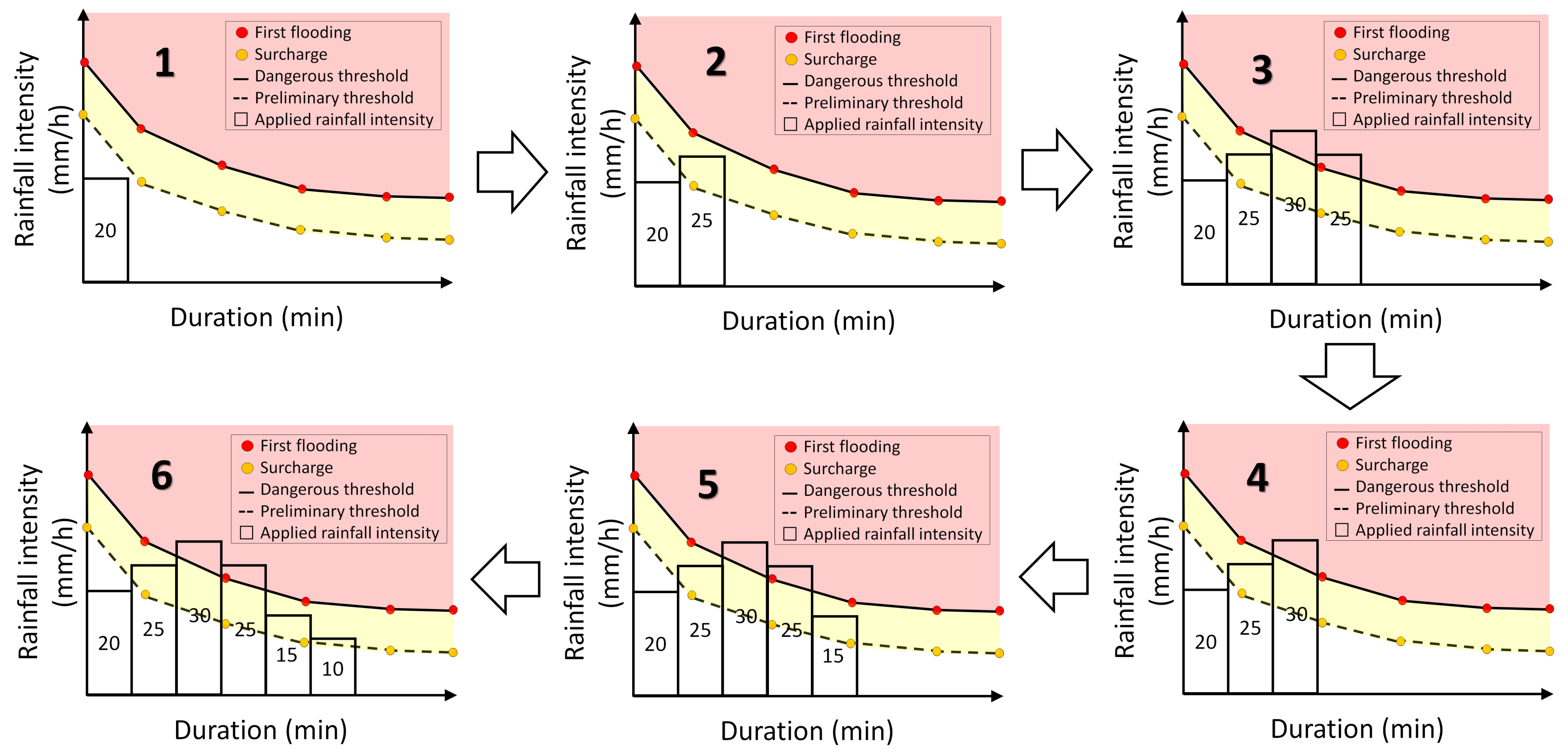
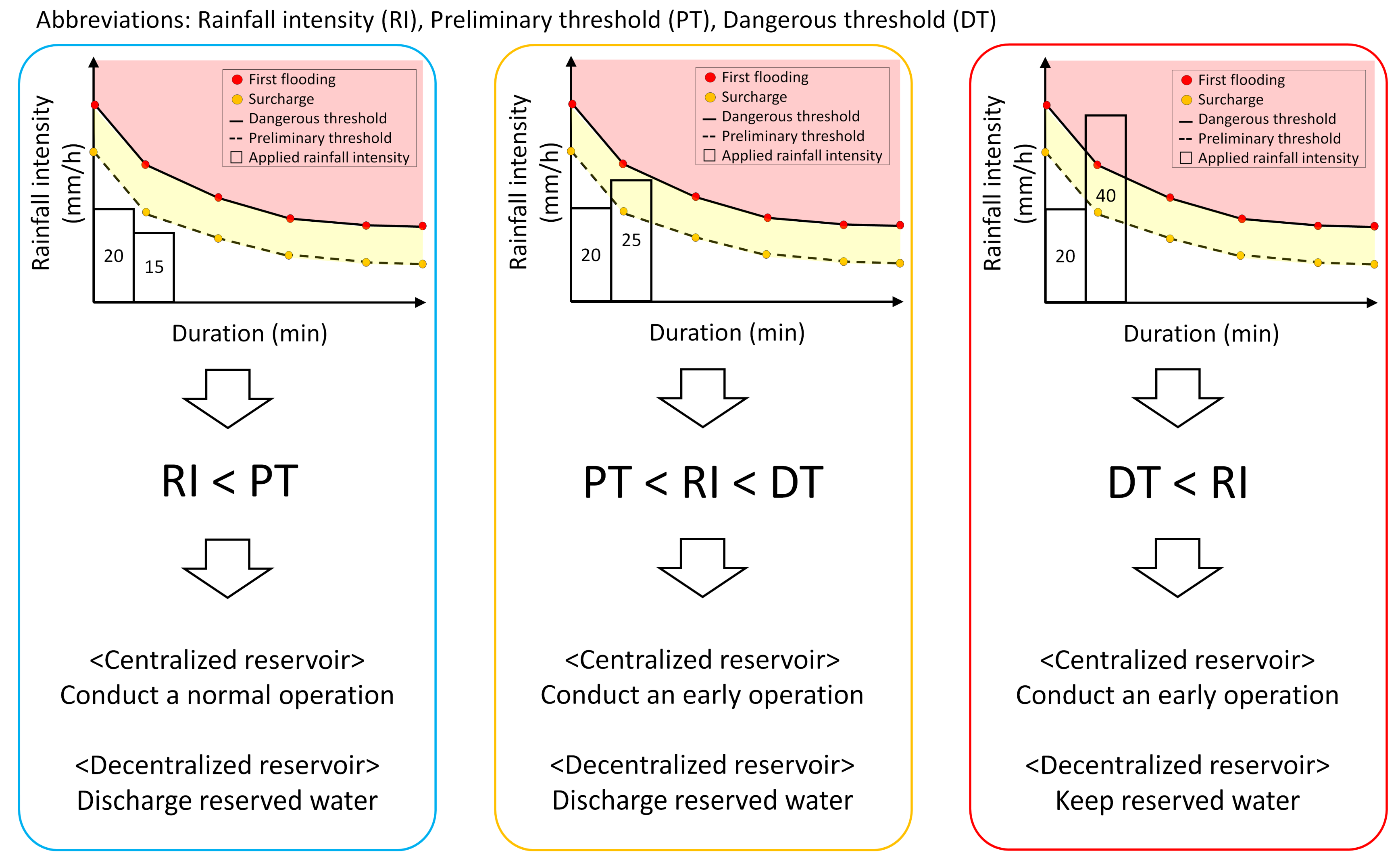
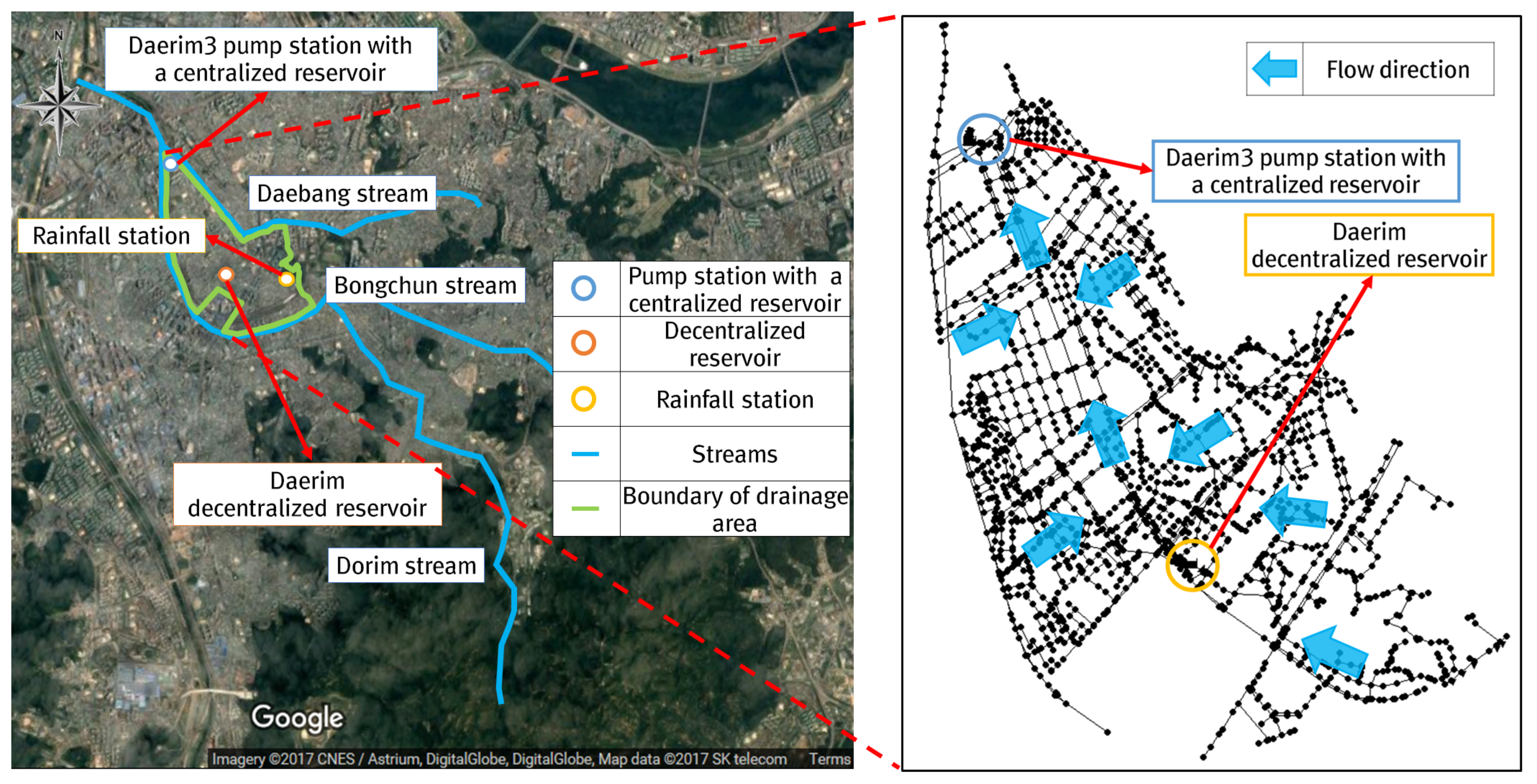
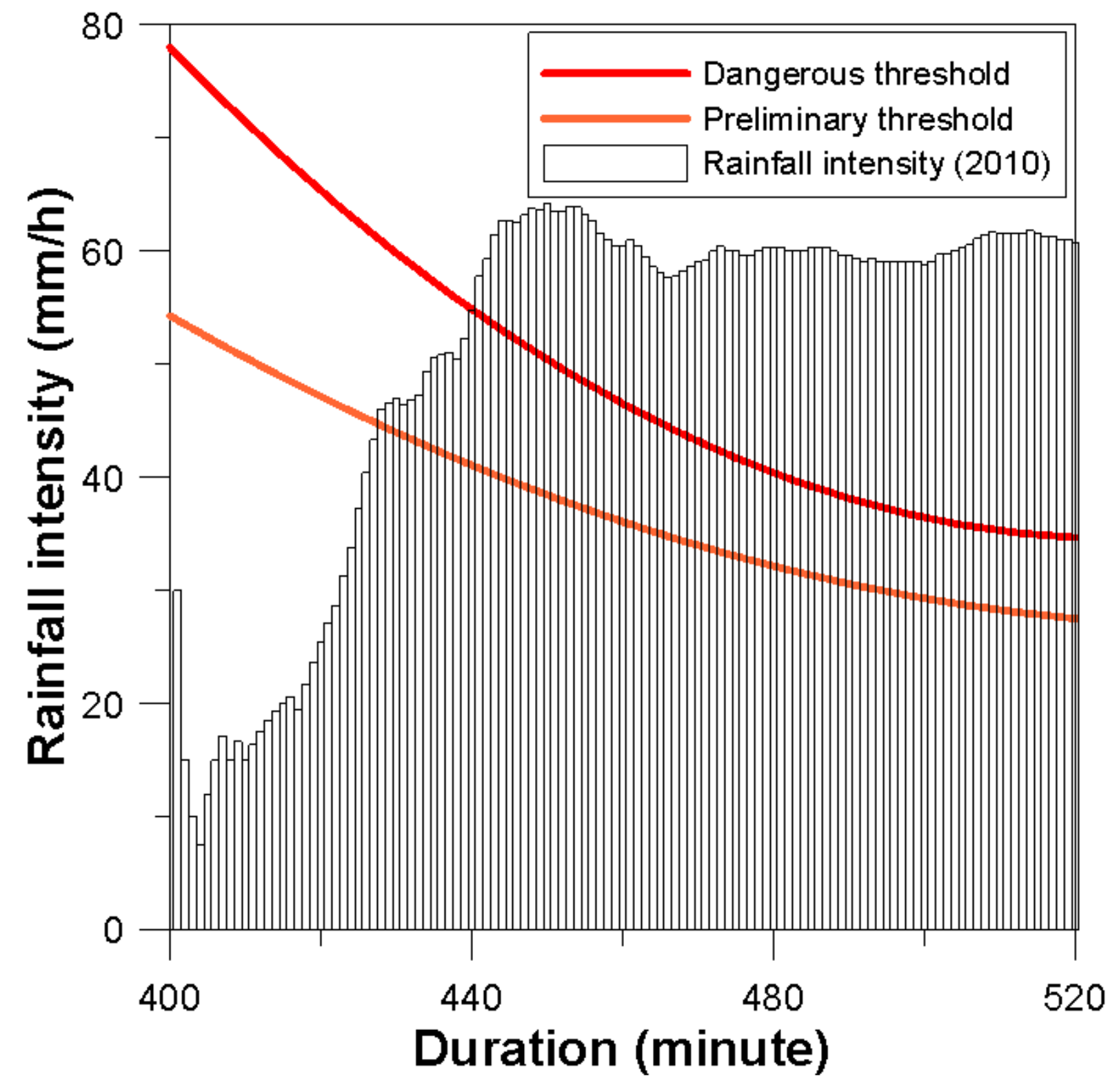
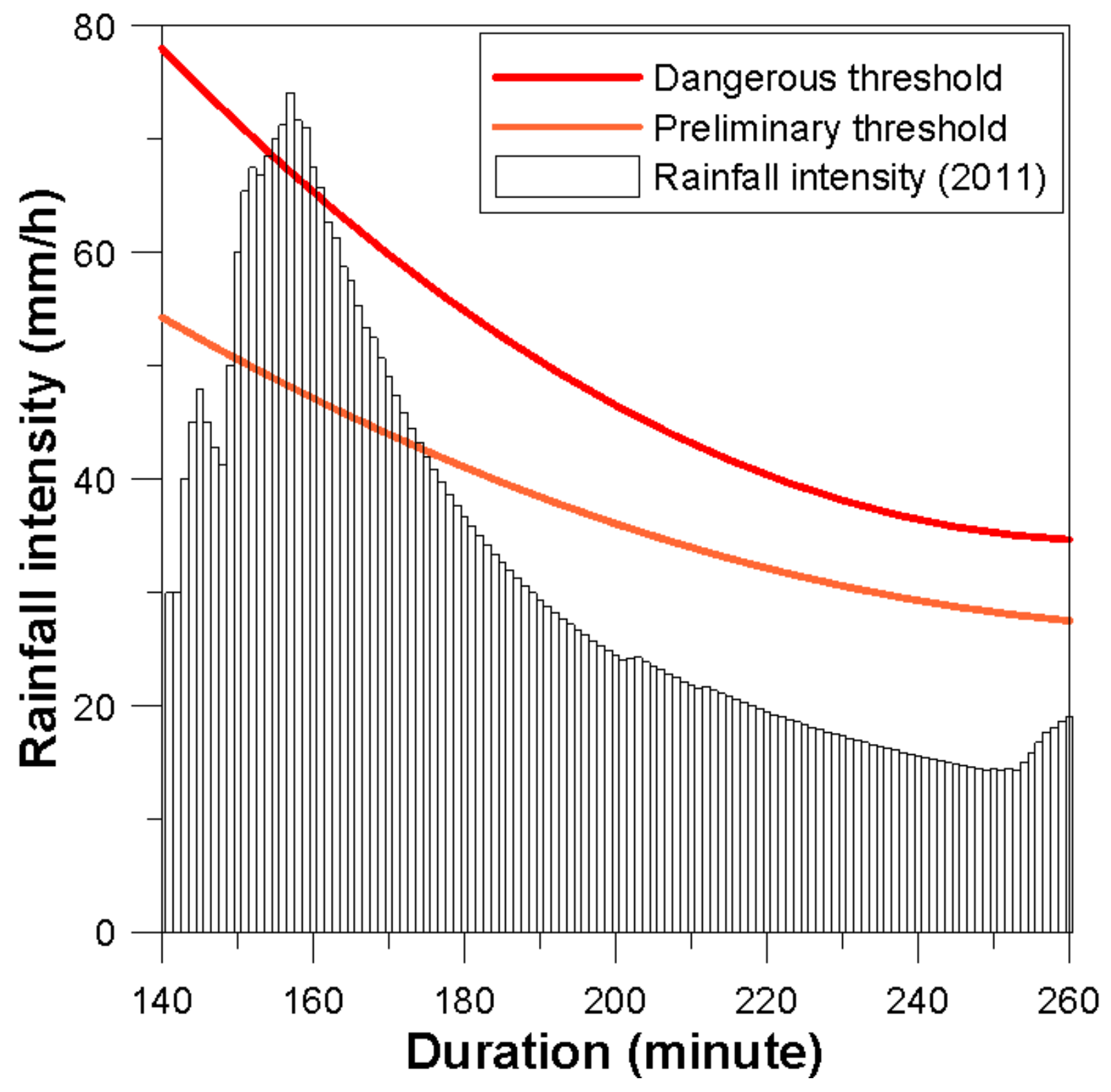
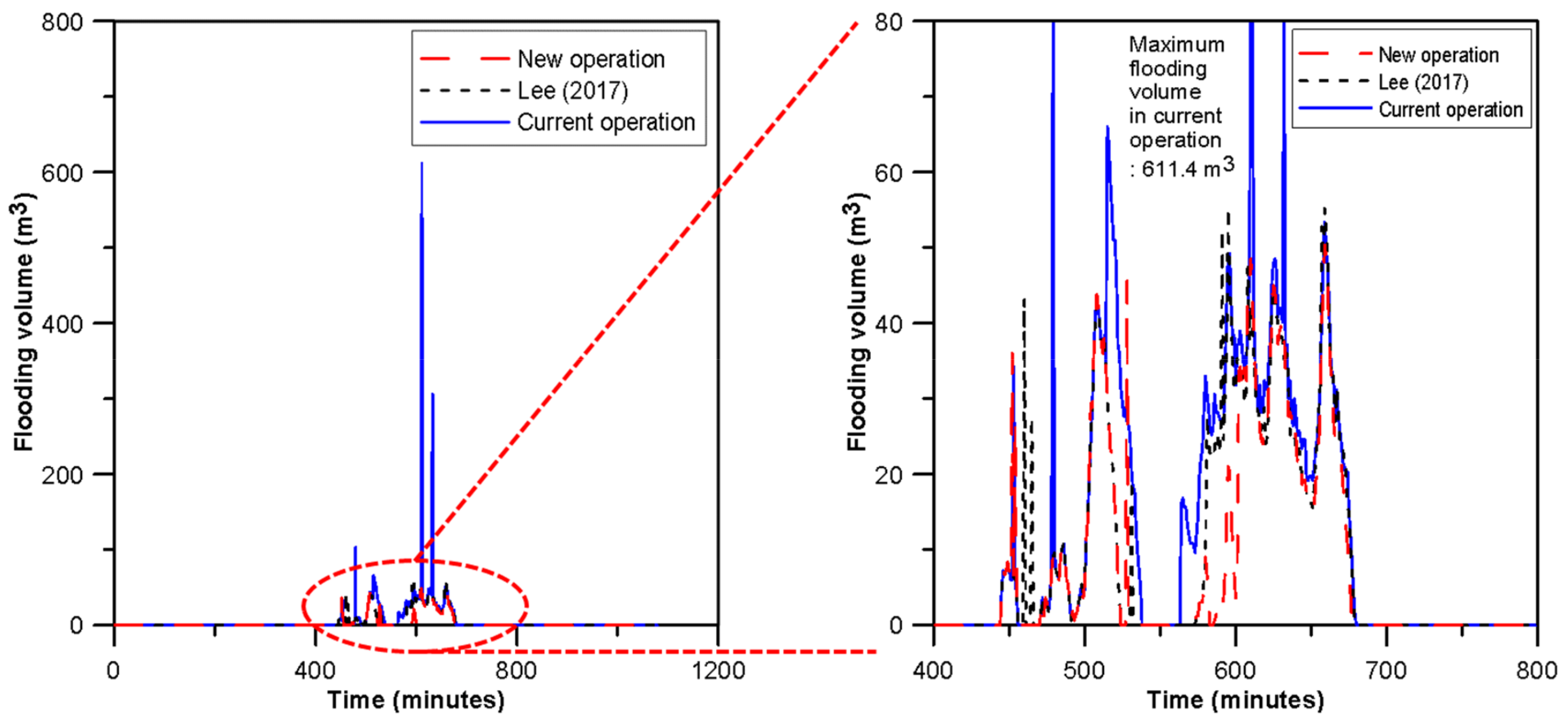
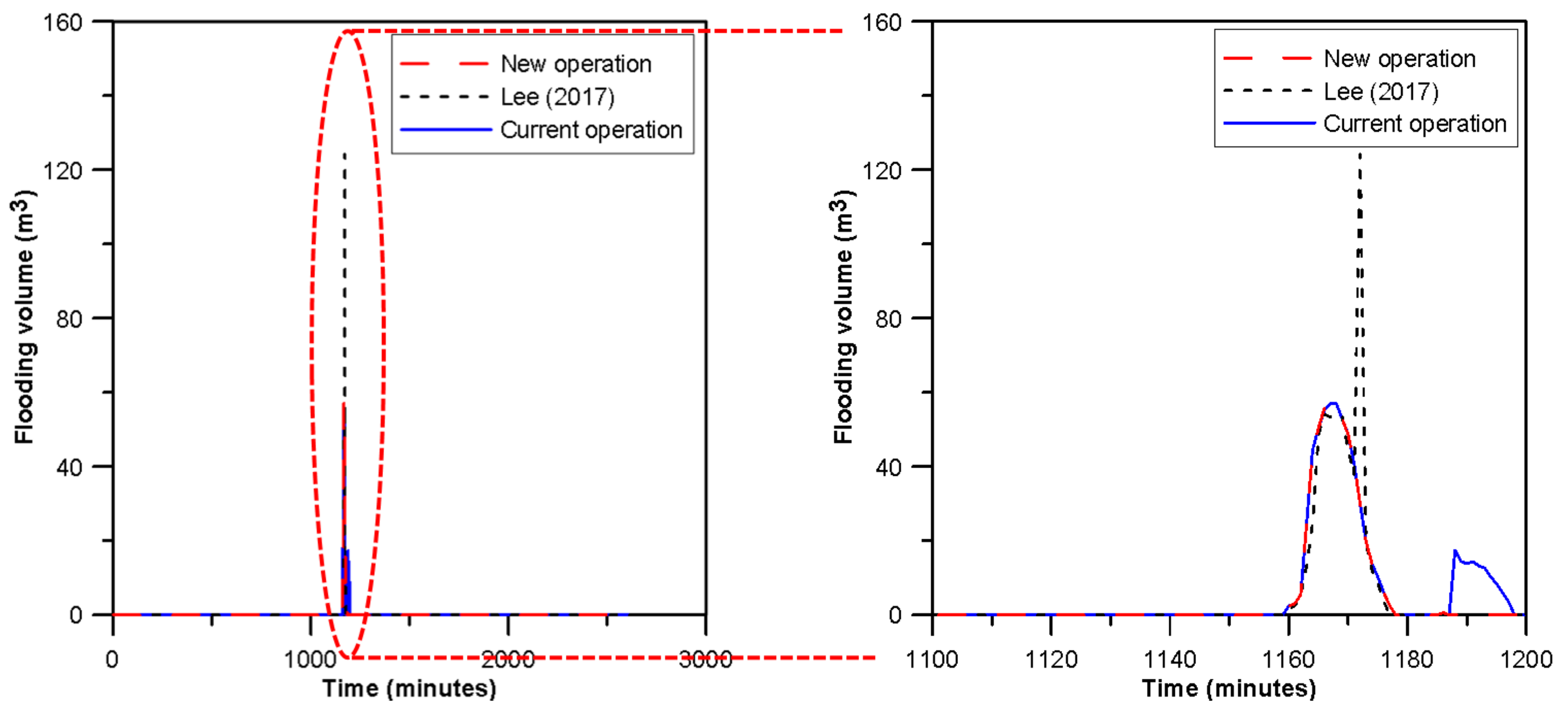

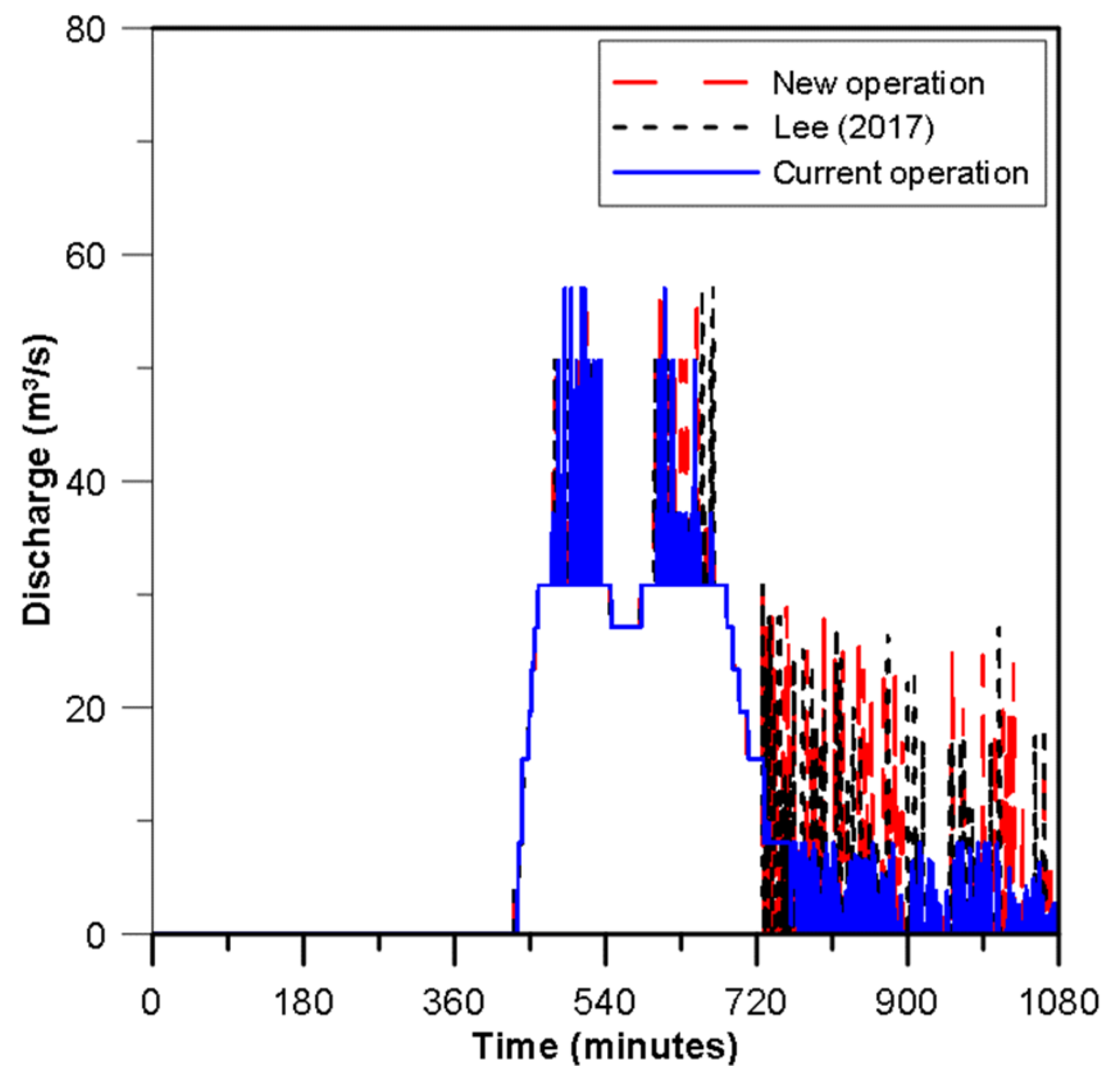


| Measures | Studies |
|---|---|
| Independent NSMs | Beeneken et al. (2013) [3]; Cembrano et al. (2004) [4]; Fiorelli et al. (2013) [5]; Fuchs and Beeneken (2005) [6]; Galelli et al. (2012) [7]; Hsu et al. (2013) [8]; Kroll (2018) [9]; Lund et al. (2018) [10]; Pleau et al. (2005) [11]; Raimondi and Becciu (2015) [12]; Schütze et al. (2004) [13]; Vanrolleghem et al. (2005) [14]; Zacharof et al. (2004) [15] |
| Combined NSMs | Lee et al. (2017) [1]; Sweetapple et al. (2018) [16] |
| Integrated NSMs | Lee et al. (2016) [17]; Xu et al. (2018) [18] |
| Mixed NSMs | This study |
| Drainage Facilities | Capacity of Reservoirs (m3) | Capacity of Drainage Pumps (m3/min) | Boundary Conditions |
|---|---|---|---|
| Daerim3 pump station with a centralized reservoir | 36,200 | 3411 (223 m3/min × 7, 150 m3/min × 1, 250 m3/min × 2, 600 m3/min × 2) | High water level: 9.0 m Low water level: 6.8 m |
| Daerim decentralized reservoir | 2477 | 18 (9.0 m3/min × 2) | Total height: 3.2 m Inflow weir: 2 m × 0.4 m |
| Pump Station | Operation | Operating Level (m) | ||||||||||||
|---|---|---|---|---|---|---|---|---|---|---|---|---|---|---|
| Daerim3 | Elevation (m) | 6.5 | 6.8 | 7.2 | 7.3 | 7.5 | 7.6 | 7.7 | 7.8 | 7.9 | 8.0 | 8.1 | 8.3 | 9.0 |
| Normal | - | - | - | 3.88 | 8.05 | 15.48 | 19.65 | 23.36 | 27.08 | 30.80 | 57.02 | 57.02 | 57.02 | |
| Early | - | 3.88 | 8.05 | 15.48 | 19.65 | 23.36 | 27.08 | 30.80 | 57.02 | 57.02 | 57.02 | - | - | |
| Event | System Resilience | |||
|---|---|---|---|---|
| Current Operation (1) | Previous Operation [16] (2) | New Operation (3) | Resilience Increment ((3) − (1)) | |
| 2010 | 0.831835 | 0.855584 | 0.866566 | 0.034731 |
| 2011 | 0.988823 | 0.992997 | 0.993029 | 0.004206 |
© 2019 by the author. Licensee MDPI, Basel, Switzerland. This article is an open access article distributed under the terms and conditions of the Creative Commons Attribution (CC BY) license (http://creativecommons.org/licenses/by/4.0/).
Share and Cite
Lee, E.H. Advanced Operating Technique for Centralized and Decentralized Reservoirs Based on Flood Forecasting to Increase System Resilience in Urban Watersheds. Water 2019, 11, 1533. https://doi.org/10.3390/w11081533
Lee EH. Advanced Operating Technique for Centralized and Decentralized Reservoirs Based on Flood Forecasting to Increase System Resilience in Urban Watersheds. Water. 2019; 11(8):1533. https://doi.org/10.3390/w11081533
Chicago/Turabian StyleLee, Eui Hoon. 2019. "Advanced Operating Technique for Centralized and Decentralized Reservoirs Based on Flood Forecasting to Increase System Resilience in Urban Watersheds" Water 11, no. 8: 1533. https://doi.org/10.3390/w11081533
APA StyleLee, E. H. (2019). Advanced Operating Technique for Centralized and Decentralized Reservoirs Based on Flood Forecasting to Increase System Resilience in Urban Watersheds. Water, 11(8), 1533. https://doi.org/10.3390/w11081533





